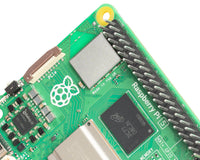
Raspberry Pi Roundup - 5th June 2016
Body Music

Calvin Cherry, an electrical engineer graduate of University of Wisconsin – Madison, has created a new musical instrument called Music from Motion which adds layers of instrumental samples as he moves different parts of his body. He has sensor packs attached to his ankles and hands which translate the orientation and speed of his limbs into readings which are sent wirelessly to an Arduino. The Arduino then sends the sensor readings to a Raspberry Pi which controls the audio output.
More pace with his left foot adds more drums; more right foot movement adds cymbals; the right hand controls more ‘flanging‘ and his left hand adds a wah-wah effect. Additional triggers such as leg flicks and hand claps trigger additional effects and samples. He used a programming tool called Pure Data to create a visualisation tool that allows him to monitor what is happening on the track.
You can read slightly more about the project, and a mini-interview with Cherry, over at The Cap Times.
My favourite quote is one to which is sure to speak to the hearts of makers everywhere:
“If you just have something you can play around with and tweak as you go along, and then make it as cool and crazy and as unmarketable as you can, it’s fun, you know?”
Instant Camera

Phillip Burgess has developed an instant camera using a Raspberry Pi, with camera module, plus a mini thermal printer from Adafruit (if you’re in the UK, take a look for the same product at Makersify). It looks like a nice fun project, and nice bit of cardboard wrangling. So, if you fancy doing a similar project, check out the tutorial on Adafruit.
Water Quality

Waterscope, a Cambridge start-up company, has developed a low-cost, 3D-printed water quality scanner based around a Raspberry Pi and a microscope. Alex Patto, Richard Bowman, Nalin Patel and Tianheng Xhao met on iTeams, a programme started at Cambridge University which aims to help staff and students develop business ideas. The aim is to develop the device into something which can be used, and reading obtained and analysed, on-site rather than being sent away for analysis. You can find out more about their efforts, and even get hold of a kit yourself by visiting their website.





